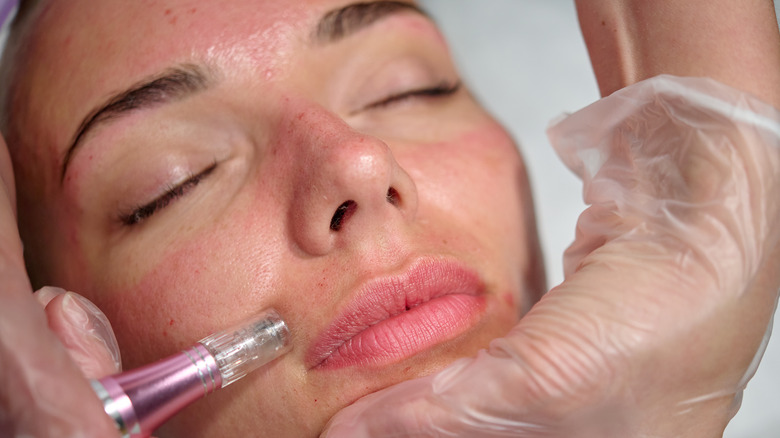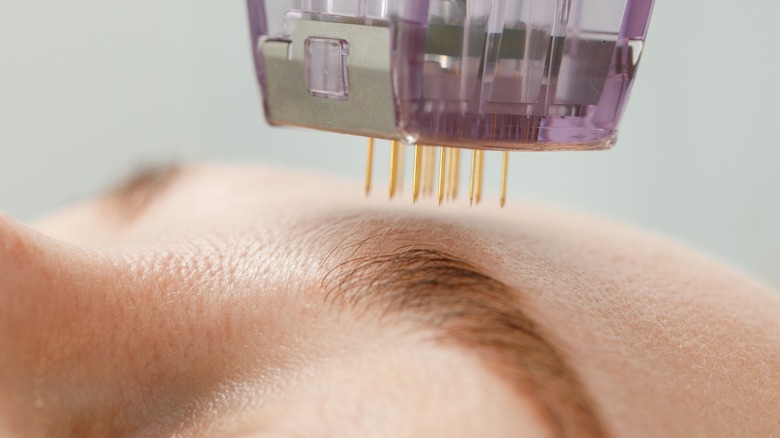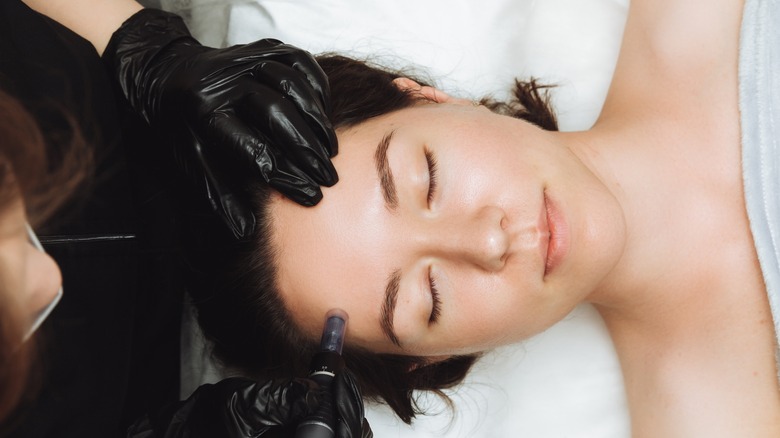The Benefit Of Radiofrequency Microneedling For Darker Skin Tones
When it comes to minimally invasive treatments for aging lines, microneedling is one of the most sought-after options. Microneedling involves making microscopic, controlled holes in the top layer of the skin with ultra-fine needles, activating a healing response and stimulating the production of collagen and elastin — the very proteins that keep the skin firm and plump. Microneedling is useful in lessening the appearance of stretch marks, acne scars, and wrinkles. Compared to other facial rejuvenation procedures that use thermal energy or injectables, microneedling has fewer and milder side effects.
Radiofrequency microneedling is a more advanced version of microneedling. The main difference between these techniques is the addition of radio frequency, a type of energy that can infiltrate your skin to stimulate new cell production for a tighter, firmer appearance, according to the Cleveland Clinic. In a 2017 study published in the journal Dermatologic Surgery, 19 patients received microneedling treatments, each receiving three sessions. After three months, 100% of patients reported improvements in the appearance of their acne scars.
Both microneedling and radiofrequency microneedling boast unique advantages in addressing dermal concerns and enhancing skin appearance. If you have a darker skin tone, though, radiofrequency microneedling may be a better option for you. This procedure has less of a chance of causing hyperpigmentation.
How radiofrequency microneedling benefits darker skin tones
According to dermatologist and skin-of-color educator Dr. Adeline Kikam, radiofrequency microneedling is designed to deliver controlled heat via microneedles. This process — which combines both radiofrequency and skin needling — is extra powerful in reducing wrinkles and renewing skin cells. Microneedling causes minor controlled trauma to the skin to spur your body into producing more collagen as part of the body's natural healing mechanism. Radiofrequency waves release heat into the skin — this added component further boosts collagen production and causes the skin to tighten, creating a sculpted look. Each procedure typically lasts anywhere between 10 and 20 minutes.
Another huge advantage of radiofrequency microneedling is that the amount of radiofrequency energy and the depth of the needles can be altered to suit the needs of each patient. Because the heat can penetrate the dermis — deeper skin layers — as opposed to the epidermis, it has minimal impact on the melanocytes in the top layers of the skin. As a result, it is unlikely to cause hyperpigmentation in people with darker skin tones.
"The advent of radiofrequency microneedling has broadened the indications for microneedling, without additional risk of side effects," dermatologist Dr. Uchenna Okekere told Byrdie. "RF with MF treats acne scars by stimulating dermal remodeling and production of dermal components with minimal risk of dyspigmentation, making it a great alternative treatment for darker skin types."
What to expect from radiofrequency microneedling
Due to its customizability, radiofrequency microneedling can be a better option for the treatment of acne scars and wrinkles than the traditional technique. Radiofrequency microneedling is able to penetrate the skin to break up old scar tissue. As far as wrinkle reduction goes, the added radiofrequency energy can further tighten underlying skin to smooth out wrinkles.
Although radiofrequency microneedling is generally safe, it also carries potential downsides and side effects. Pinpoint bleeding, mild bruising, temporary discoloration, redness, swelling, and itching are not uncommon during treatment. After the procedure, expect mild swelling and redness, which will go away within a few hours. You may also develop minor scabs on the treated sites, but you should let them peel off on their own. If you have any persistent discomfort, speak to your physician.
While speaking to Byrdie, Dr. Uchenna Okekere advised abstaining from anti-inflammatory medications for two weeks prior to the procedure to reduce the likelihood of flare-ups. Radiofrequency microneedling also boasts minimal downtime — you can go home after the procedure. However, you should refrain from physical activity for at least one day and only start to wear makeup two to three days after your treatment. Skincare-wise, wash your face with a gentle cleanser, apply a soothing recovery cream to your treated sites, and wear sunscreen daily to help your skin heal.


